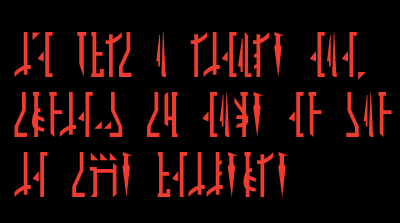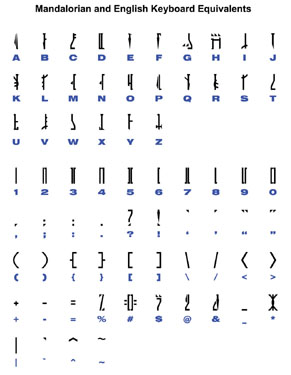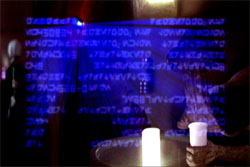Disclaimer:
|
|||||||||||||||||
 |
||
Mandalorian Font
This Star Wars font is based on officially released information, samples of Mandalorian seen in the Episode II Visual Dictionary, as well as menu screens from the 2004 DVD release of the Star Wars Trilogy. NOTE: This is version 2 of the font, updated with recent discoveries.
This font includes all English letters, numbers, and common punctuation marks (basically, all the stuff displayed on the keyboard). Uppercase and lowercase letters are identical. Also, kerning has been enabled for this font (see "What is kerning?" on my Fonts FAQ page for a discussion of kerning). Here's a full table of Mandalorian letters and their respective keys.
Accuracy of This FontMy main source for this font is a menu screen taken from the 2004 release of the Star Wars DVDs. When you have the disk for Episode IV - A New Hope loaded, you need to make sure you are viewing the Tatooine theme. When you select Options, you'll be brought into the cantina, where you'll see different alien alphabets quickly flash on your screen before the actual options are displayed. Two of the alien alphabets displayed are Aurebesh and Mandalorian, shown below.
By comparing these two screens, I noticed that the number of letters in each line was the same, regardless of the alphabet. In other words, they said the exact same thing, only in different alphabets. The only trick is the middle column: on the Aurebesh screen it's the same as the right column; on the Mandalorian screen, it's the same as the left column, only flipped updside-down. Once I realized this, all I had to do was "translate" the Aurebesh back into English, and then I would have the character values for the Mandalorian. Unfortunately, there were some letters and numbers that were not present: m, p, q, v, x, z, 1, 2, and 0. Thanks to recent discoveries, updated and accurate versions of letters m, p, q, v, x, and z are now included in version 2 of the font. For the punctuation and numbers (1, 2, and 0), I used the official letters as inspiration to fill in the gaps. You may notice that letter c is different in my font as compared to some of the other available Mandalorian fonts. This is my own creative decision, backed up by my screenshot analysis, and based on the fact that other fonts include the same character for letters c and u. And in case you're curious, the DVD screen doesn't "say" anything. It's just a jumble of random letters and numbers. Is it Really Mandalorian?Yes. In the Episode II Visual Dictionary, there's a small readout of the technical display from the Slave I. Check it out below, and you can clearly see the similarity between it and the alphabet that appears on the DVD.
|
This
page last modified on
7/13/2010
Return to Top




